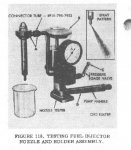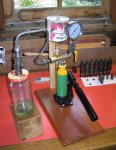chuck, have you ever seen a MF injector on a test pump? i have a tester and they seem to put out the same mist that other injectors do. just wondering, injectors in cat and cummins spray almost sideways across the piston top while the MF sprays down into the cup. i wonder if that fact alone is enough to burn the fuel more slowly.
tom
Hi Tom,
No, I have never put an MF injector on a tester. I have been looking for a manual test pump with my name on it, but have not found it yet. Got a spare?
As I understand it, the MF injector has multiple personalities: Thick fuels will atomize because you are pushing large molecules through the orifice at very high pressure, thin fuels will just stream because the pressure is so much less.
The engineering texts I have read on IC engine design said that this feature was used to great advantage in the MF.
Gasoline if allowed to atomize would burn instantly as it was leaving the orifice; using up the air around the injector, and quickly coking its tip. Because of that fact, the orifice size was chosen so that gasoline squirts unburnt onto the walls and bottom of the relatively cool combustion chamber, and as the hot pressurized air in the chamber makes the gasoline boil, the vapors then ignite. This process takes a fairly long time, and happens far away from the injector nozzle.
Medium grade fuels, like diesel oil, pass through the injector nozzle somewhere between atomizing, and streaming. As a result, partly boil off of the bottom of the chamber, and partly burn in the hot air... they still burn more slowly, and over a much longer time than they would in a conventional diesel... hence the name: Whisper Diesel.
Heavier fuel oils pass through the injector at a much higher pressure, and atomizes more completely, but the resulting fractured globs are big and heavy, and burn quite slowly when exposed to the hot air in the combustion chamber.
I have heard SS members describe the sound of their MF engine burning straight gasoline as sounding like it was crackling, or spattering.... we all know that an MF engine burning diesel oil sounds smoother and quieter than a usual diesel engine..., but straight motor oil sounds even more muffled and silky smooth in comparison.
I believe that if you want to get a true picture of the character of the MF injector, you will have to try it with gasoline, diesel oil, and motor oil as test fluids.
-Chuck




